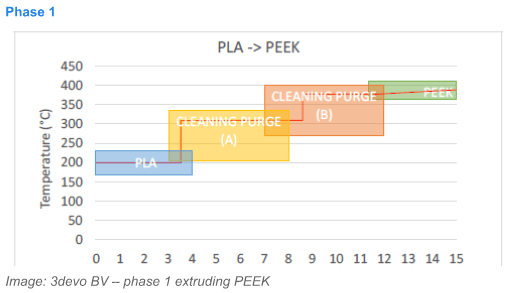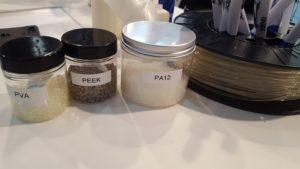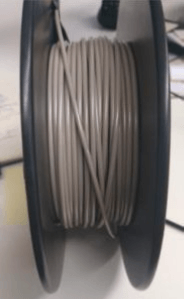3devo Completes PEEK Material Trials with NEXT 1.0 Advanced Level Desktop Filament Extruder
 Netherlands-based 3devo, a subsidiary of Devoteq, may have only been officially around for about a year, but the company is stirring things up in a good way. Its goal is to find a way to provide industrial-grade filament production capabilities in a consumer-priced system with a desktop-sized footprint. The company wants to enhance the filament production process, so that manufacturers and users of desktop 3D printers alike can improve the entire process.
Netherlands-based 3devo, a subsidiary of Devoteq, may have only been officially around for about a year, but the company is stirring things up in a good way. Its goal is to find a way to provide industrial-grade filament production capabilities in a consumer-priced system with a desktop-sized footprint. The company wants to enhance the filament production process, so that manufacturers and users of desktop 3D printers alike can improve the entire process.
The NEXT 1.0 extruder lets users easily recycle old 3D prints and filaments, and was marketed towards 3D printing shops, makers, and universities. The 3devo Advanced allows researchers and extrusion, plastic, and 3D printing companies to create small batch productions of unique 3D printing filaments or variants in a cost-effective way. Both machines have different heating zones that are able to be set to certain temperatures independent of the others; the NEXT 1.0 has three zones, and the Advanced has four. The Advanced also features a mixing section built right into the extruder screw, designed to extrude higher-temperature materials, like PEEK.
PEEK, or Polyether Ether Ketone, is a semi-crystalline thermoplastic that features chemical and mechanical properties that make it capable of sustaining high temperatures. This material was the focus of 3devo’s most recent experiment. The main uses for PEEK lie in three specific industries: as the material is durable, strong, and lightweight in a wide temperature range, and has a low price tag, it is a popular choice for the aerospace sector. These features, coupled with its energy efficiency and the ability to reduce vibrations, make PEEK perfect for the automotive industry. Finally, the material has similar properties to bone, which makes it one of the only 3D printing materials the human body doesn’t resist. So this unique thermoplastic also calls the medical industry home.
According to 3devo’s Lisette van Gent, “Working with PEEK has presented interesting challenges, chief among which involved extruding it in the correct temperature range, while factoring in internal pressure, and without affecting the material’s crystallinity.”
 The company’s first PEEK trials, with the NEXT 1.0 Advanced Level desktop filament extruder, were easier than first predicted. van Gent says that one of the challenges in switching from PLA to PEEK was building up the internal extruder temperature to 343°, the high melting point for PEEK. Two phases were used to tackle this challenge, using two separate cleaning compounds as transition materials.
The company’s first PEEK trials, with the NEXT 1.0 Advanced Level desktop filament extruder, were easier than first predicted. van Gent says that one of the challenges in switching from PLA to PEEK was building up the internal extruder temperature to 343°, the high melting point for PEEK. Two phases were used to tackle this challenge, using two separate cleaning compounds as transition materials.
The temperature was first slowly raised from 170° to 300°, using the first of the transition materials. Once the temperature had risen past the 300° point, researchers switched over to the second transition material, to reach 390°. This point was the final trial stage, where researchers could begin to extrude the PEEK material. van Gent noted that the transition materials were very important to the whole extrusion process:
“We first mixed the PEEK with the transition material, and then gradually lowered the temperature range while increasing the amount of transition material in the mix.”
It was simpler than expected to extrude the material to the desired thickness, either 1.75mm or 2.85 mm, due to its quick cooling properties and steady flow. However, van Gent admits that winding the extruded PEEK around a material spool was an altogether different story. Researchers ended up having to tape the first part of the filament to the spool to help it wind around correctly, because the material was so strong; this was also helpful in preventing the filament from popping out of the spool once it was wound around it.
3devo says that there are definitely advantages to extruding your own PEEK material. It is wide open for experimentation: by adding in different materials, such as carbon fiber, to the PEEK granules, users can try to create their own custom composites. Additionally, it can be a cost-saving measure. You will only spend €100 per kg of PEEK granulate when you buy from 3devo; a whole filament spool could cost upwards of €1000. The 3devo team is aware that high prices for printing material can undercut the accessibility of desktop 3D printers, and plans to make materials manufacturing as simple as consumer 3D printers. 3devo said that in the next software update, PEEK profile settings will be added to the NEXT 1.0 Advanced Level extruder, for both 1.75mm and 2.85mm PEEK filament. Discuss in the 3devo forum at 3DPB.com.
Subscribe to Our Email Newsletter
Stay up-to-date on all the latest news from the 3D printing industry and receive information and offers from third party vendors.
Print Services
You May Also Like
Low-cost “Suzy” Polymer Powder 3D Printer is Faster and Cheaper than Past Models
Polish laser powder bed fusion (LPBF) firm Sinterit has released a follow-up to its predecessors, Lisa and Nils, called Suzy, a $19,490 printer equipped with a 30W fiber diode laser....
India’s $58M Space Fund Is a Boon for AM Innovation
India’s space industry is picking up serious momentum. With a projected $44 billion space economy by 2033, the country is aggressively expanding its capabilities, fostering private-sector participation, and reducing its...
Japanese Advanced Manufacturing Capabilities Grow in Europe with Sodick’s Purchase of Prima Additive
The global economy is currently undergoing a reshuffling in terms of what gets manufactured where. In large part, this trend is being driven by new geopolitical alliances and the need...
Bosch Invests €6M into Serial Auto Part 3D Printing
German industrial conglomerate Robert Bosch GmbH, the world’s largest supplier of automotive parts, has announced a new investment into Nuremberg, Germany additive manufacturing (AM) facility. The nearly €6 million in...
































